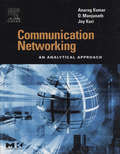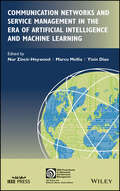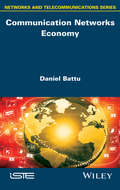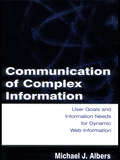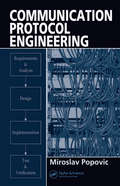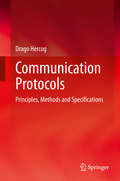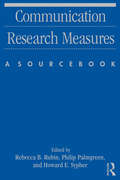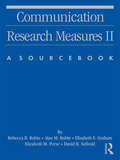- Table View
- List View
Communication Networking: An Analytical Approach (ISSN)
by Anurag Kumar D. Manjunath Joy KuriCommunication Networking is a comprehensive, effectively organized introduction to the realities of communication network engineering. Written for both the workplace and the classroom, this book lays the foundation and provides the answers required for building an efficient, state-of-the-art network—one that can expand to meet growing demand and evolve to capitalize on coming technological advances. It focuses on the three building blocks out of which a communication network is constructed: multiplexing, switching, and routing. The discussions are based on the viewpoint that communication networking is about efficient resource sharing. The progression is natural: the book begins with individual physical links and proceeds to their combination in a network. The approach is analytical: discussion is driven by mathematical analyses of and solutions to specific engineering problems. Fundamental concepts are explained in detail and design issues are placed in context through real world examples from current technologies. The text offers in-depth coverage of many current topics, including network calculus with deterministically-constrained traffic; congestion control for elastic traffic; packet switch queuing; switching architectures; virtual path routing; and routing for quality of service. It also includes more than 200 hands-on exercises and class-tested problems, dozens of schematic figures, a review of key mathematical concepts, and a glossary. This book will be of interest to networking professionals whose work is primarily architecture definition and implementation, i.e., network engineers and designers at telecom companies, industrial research labs, etc. It will also appeal to final year undergrad and first year graduate students in EE, CE, and CS programs.Systematically uses mathematical models and analyses to drive the development of a practical understanding of core network engineering problems.Provides in-depth coverage of many current topics, including network calculus with deterministically-constrained traffic, congestion control for elastic traffic, packet switch queuing, switching architectures, virtual path routing, and routing for quality of service.Includes over 200 hands-on exercises and class-tested problems, dozens of schematic figures, a review of key mathematical concepts, and a glossary.
Communication Networks: A Concise Introduction, Second Edition (Synthesis Lectures on Learning, Networks, and Algorithms)
by Jean Walrand Shyam ParekhThis book results from many years of teaching an upper division course on communication networks in the EECS department at the University of California, Berkeley. It is motivated by the perceived need for an easily accessible textbook that puts emphasis on the core concepts behind current and next generation networks. After an overview of how today's Internet works and a discussion of the main principles behind its architecture, we discuss the key ideas behind Ethernet, WiFi networks, routing, internetworking, and TCP. To make the book as self-contained as possible, brief discussions of probability and Markov chain concepts are included in the appendices. This is followed by a brief discussion of mathematical models that provide insight into the operations of network protocols. Next, the main ideas behind the new generation of wireless networks based on LTE, and the notion of QoS are presented. A concise discussion of the physical layer technologies underlying various networks is also included. Finally, a sampling of topics is presented that may have significant influence on the future evolution of networks, including overlay networks like content delivery and peer-to-peer networks, sensor networks, distributed algorithms, Byzantine agreement, source compression, SDN and NFV, and Internet of Things.
Communication Networks: A Concise Introduction (Synthesis Lectures on Learning, Networks, and Algorithms)
by Jean Walrand Shyam ParekhThis book results from many years of teaching an upper division course on communication networks in the EECS department at University of California, Berkeley. It is motivated by the perceived need for an easily accessible textbook that puts emphasis on the core concepts behind current and next generation networks. After an overview of how today's Internet works and a discussion of the main principles behind its architecture, we discuss the key ideas behind Ethernet, WiFi networks, routing, internetworking and TCP. To make the book as self contained as possible, brief discussions of probability and Markov chain concepts are included in the appendices. This is followed by a brief discussion of mathematical models that provide insight into the operations of network protocols. Next, the main ideas behind the new generation of wireless networks based on WiMAX and LTE, and the notion of QoS are presented. A concise discussion of the physical layer technologies underlying various networks is also included. Finally, a sampling of topics is presented that may have significant influence on the future evolution of networks including overlay networks like content delivery and peer-to-peer networks, sensor networks, distributed algorithms, Byzantine agreement and source compression. Table of Contents: The Internet / Principles / Ethernet / WiFi / Routing / Internetworking / Transport / Models / WiMAX & LTE / QOS / Physical Layer / Additional Topics
Communication Networks and Service Management in the Era of Artificial Intelligence and Machine Learning (IEEE Press Series on Networks and Service Management)
by Nur Zincir-HeywoodCOMMUNICATION NETWORKS AND SERVICE MANAGEMENT IN THE ERA OF ARTIFICIAL INTELLIGENCE AND MACHINE LEARNING Discover the impact that new technologies are having on communication systems with this up-to-date and one-stop resource Communication Networks and Service Management in the Era of Artificial Intelligence and Machine Learning delivers a comprehensive overview of the impact of artificial intelligence (AI) and machine learning (ML) on service and network management. Beginning with a fulsome description of ML and AI, the book moves on to discuss management models, architectures, and frameworks. The authors also explore how AI and ML can be used in service management functions like the generation of workload profiles, service provisioning, and more. The book includes a handpicked selection of applications and case studies, as well as a treatment of emerging technologies the authors predict could have a significant impact on network and service management in the future. Statistical analysis and data mining are also discussed, particularly with respect to how they allow for an improvement of the management and security of IT systems and networks. Readers will also enjoy topics like: A thorough introduction to network and service management, machine learning, and artificial intelligence An exploration of artificial intelligence and machine learning for management models, including autonomic management, policy-based management, intent based management, and network virtualization-based management Discussions of AI and ML for architectures and frameworks, including cloud systems, software defined networks, 5G and 6G networks, and Edge/Fog networks An examination of AI and ML for service management, including the automatic generation of workload profiles using unsupervised learning Perfect for information and communications technology educators, Communication Networks and Service Management in the Era of Artificial Intelligence and Machine Learning will also earn a place in the libraries of engineers and professionals who seek a structured reference on how the emergence of artificial intelligence and machine learning techniques is affecting service and network management.
Communication Networks and Service Management in the Era of Artificial Intelligence and Machine Learning (IEEE Press Series on Networks and Service Management)
by Nur Zincir-Heywood Yixin Diao Marco MelliaCOMMUNICATION NETWORKS AND SERVICE MANAGEMENT IN THE ERA OF ARTIFICIAL INTELLIGENCE AND MACHINE LEARNING Discover the impact that new technologies are having on communication systems with this up-to-date and one-stop resource Communication Networks and Service Management in the Era of Artificial Intelligence and Machine Learning delivers a comprehensive overview of the impact of artificial intelligence (AI) and machine learning (ML) on service and network management. Beginning with a fulsome description of ML and AI, the book moves on to discuss management models, architectures, and frameworks. The authors also explore how AI and ML can be used in service management functions like the generation of workload profiles, service provisioning, and more. The book includes a handpicked selection of applications and case studies, as well as a treatment of emerging technologies the authors predict could have a significant impact on network and service management in the future. Statistical analysis and data mining are also discussed, particularly with respect to how they allow for an improvement of the management and security of IT systems and networks. Readers will also enjoy topics like: A thorough introduction to network and service management, machine learning, and artificial intelligence An exploration of artificial intelligence and machine learning for management models, including autonomic management, policy-based management, intent based management, and network virtualization-based management Discussions of AI and ML for architectures and frameworks, including cloud systems, software defined networks, 5G and 6G networks, and Edge/Fog networks An examination of AI and ML for service management, including the automatic generation of workload profiles using unsupervised learning Perfect for information and communications technology educators, Communication Networks and Service Management in the Era of Artificial Intelligence and Machine Learning will also earn a place in the libraries of engineers and professionals who seek a structured reference on how the emergence of artificial intelligence and machine learning techniques is affecting service and network management.
Communication Networks Economy
by Daniel BattuIn an increasingly interconnected world, "Communication Networks Economy" provides the rational understanding necessary to provide universal access to communication means in an efficient way. This book presents the principal elements of the economics of a network as it stands today, taking into account experiences of technicians in the field. The author gives a simplified picture of the current situation in terms of structures and architecture of a network, bearing in mind the necessary quality of service and the profitability of investments, accompanied by references to recent economic works. An overview is given on the general themes of regulation and tariff principles, and the relations between supply and demand, from the perspectives of professional and residential users and network operators. Different aspects of the present situations of networks and the incidence of the Internet on the economy are also presented. In conclusion, the reader will obtain an overview of the most significant issues likely to influence the economics of communications networks as they are today.
Communication Networks Economy
by Daniel BattuIn an increasingly interconnected world, "Communication Networks Economy" provides the rational understanding necessary to provide universal access to communication means in an efficient way. This book presents the principal elements of the economics of a network as it stands today, taking into account experiences of technicians in the field. The author gives a simplified picture of the current situation in terms of structures and architecture of a network, bearing in mind the necessary quality of service and the profitability of investments, accompanied by references to recent economic works. An overview is given on the general themes of regulation and tariff principles, and the relations between supply and demand, from the perspectives of professional and residential users and network operators. Different aspects of the present situations of networks and the incidence of the Internet on the economy are also presented. In conclusion, the reader will obtain an overview of the most significant issues likely to influence the economics of communications networks as they are today.
Communication of Complex Information: User Goals and Information Needs for Dynamic Web Information
by Michael J. AlbersThe amount of information available for any realistic complex situation is likely to overwhelm most users, as well as stymie any designer tasked with presenting the information. Providing large amounts of information in a coherent and usable format remains an unresolved problem. Choosing, structuring, formatting, and displaying information to allow easy access and to facilitate understanding are critical issues for effective design. To build an effective design that addresses complex information needs, one must look at research from psychology, sociology, human computer interaction, and technical communication, and develop a complete picture of the situation. This book develops a foundation for analysis and design of the approaches to providing complex information in real-world situations. Author Michael Albers takes the view that the content of the information system is the most important component. As such, this volume presents the analysis that needs to be done before the interface is designed and before content is created. It strives to provide clear understanding of how the user thinks and what the user needs, so interface operation, content, and presentation can maximize their respective potentials in communicating with a user. This volume is intended for technical communicators, human-computer interaction designers, and information designers. It will also be useful for system designers and researchers, and those studying adaptive hypertext and related topics.
Communication of Complex Information: User Goals and Information Needs for Dynamic Web Information
by Michael J. AlbersThe amount of information available for any realistic complex situation is likely to overwhelm most users, as well as stymie any designer tasked with presenting the information. Providing large amounts of information in a coherent and usable format remains an unresolved problem. Choosing, structuring, formatting, and displaying information to allow easy access and to facilitate understanding are critical issues for effective design. To build an effective design that addresses complex information needs, one must look at research from psychology, sociology, human computer interaction, and technical communication, and develop a complete picture of the situation. This book develops a foundation for analysis and design of the approaches to providing complex information in real-world situations. Author Michael Albers takes the view that the content of the information system is the most important component. As such, this volume presents the analysis that needs to be done before the interface is designed and before content is created. It strives to provide clear understanding of how the user thinks and what the user needs, so interface operation, content, and presentation can maximize their respective potentials in communicating with a user. This volume is intended for technical communicators, human-computer interaction designers, and information designers. It will also be useful for system designers and researchers, and those studying adaptive hypertext and related topics.
Communication of Politics: 8th Inte
by Bruce I NewmanLearn how political marketing and public relations affect the electoral process! Communication of Politics: Cross-Cultural Theory Building in the Practice of Public Relations and Political Marketing examines how communication and marketing experts influence politics. The book reviews the state of the art in political communication management and marketing through a cross-cultural integration of research and theoretical approaches. An international panel of authors presents a comparative assessment of the impact of candidate and party appeals on the electorate, examines case studies from elections in the United States and Europe, and offers innovative models of voter behavior in the United States, Poland, and Slovenia. Communication of Politics provides valuable insights into the merger of political marketing and public relations. The book examines the cause and effect of the increasing role of communications professionals in the political process and documents the relationship between politicians and communications professionals working in electoral committees, political parties, governments, government agencies, consultancies, and polling agencies. Topics addressed by the international panel of scholars and practitioners include: a critical assessment of strategies used in the 2000 United States Presidential election branding as a means of establishing party values and winning support the expanding roles of polls, focus groups and Internet-based research on elections the relationship between foreign affairs/diplomacy and media/public relations Quangos (Quasi-Autonomous Non-Governmental Organizations) and much more! Communication of Politics: Cross-Cultural Theory Building in the Practice of Public Relations and Political Marketing examines the innovative-and sometimes controversial-uses of contemporary electoral marketing. The book is an essential resource for academics, journalists, and political practitioners, including campaign managers, charity fundraisers, public service managers, party-policy-makers-even candidates.
Communication of Politics: 8th Inte
by Bruce I NewmanLearn how political marketing and public relations affect the electoral process! Communication of Politics: Cross-Cultural Theory Building in the Practice of Public Relations and Political Marketing examines how communication and marketing experts influence politics. The book reviews the state of the art in political communication management and marketing through a cross-cultural integration of research and theoretical approaches. An international panel of authors presents a comparative assessment of the impact of candidate and party appeals on the electorate, examines case studies from elections in the United States and Europe, and offers innovative models of voter behavior in the United States, Poland, and Slovenia. Communication of Politics provides valuable insights into the merger of political marketing and public relations. The book examines the cause and effect of the increasing role of communications professionals in the political process and documents the relationship between politicians and communications professionals working in electoral committees, political parties, governments, government agencies, consultancies, and polling agencies. Topics addressed by the international panel of scholars and practitioners include: a critical assessment of strategies used in the 2000 United States Presidential election branding as a means of establishing party values and winning support the expanding roles of polls, focus groups and Internet-based research on elections the relationship between foreign affairs/diplomacy and media/public relations Quangos (Quasi-Autonomous Non-Governmental Organizations) and much more! Communication of Politics: Cross-Cultural Theory Building in the Practice of Public Relations and Political Marketing examines the innovative-and sometimes controversial-uses of contemporary electoral marketing. The book is an essential resource for academics, journalists, and political practitioners, including campaign managers, charity fundraisers, public service managers, party-policy-makers-even candidates.
Communication Perspectives on HIV/AIDS for the 21st Century (Routledge Communication Series)
by Timothy Edgar Seth M. Noar Vicki S. FreimuthReflecting the current state of research into the communication aspects of HIV/AIDS, this volume explores AIDS-related communication scholarship, moving forward from the 1992 publication AIDS: A Communication Perspective. Editors Timothy Edgar, Seth M. Noar, and Vicki S. Freimuth have developed this up-to-date collection to focus on today’s key communication issues in the HIV/AIDS epidemic. Chapters herein examine the interplay of the messages individuals receive about AIDS at the public level as well as the messages exchanged between individuals at the interpersonal level. Acknowledging how the face of HIV/AIDS has changed since 1992, the volume promotes the perspective that an understanding of effective communication through both mediated and interpersonal channels is essential to winning the continued battle against AIDS. Issues addressed here include: Social stigma associated with the disease, social support and those living with HIV/AIDS, and the current state of HIV testing Parent–child discussions surrounding HIV/AIDS and safer sexual behavior, and cultural sensitivity relating to developing HIV prevention and sex education programs The effectiveness of health campaigns to impact attitudes, norms, and behavior, as well as the current state of entertainment education and its ability to contribute to HIV prevention News media coverage of HIV/AIDS and the impact of the agenda-setting function on public opinion and policy making Health literacy and its importance to the health and well-being of those undergoing HIV treatment. The role of technological innovations, most notably the Internet, used for both prevention interventions as well as risky behavior The volume also includes exemplars that showcase the diversity of approaches to health communication used to combat the HIV/AIDS epidemic. These cases include interpersonal and mass communication mediums; traditional along with new media and technology; research by academics and practitioners; individual as well as community-based approaches; work based in the United States and internationally; and campaigns directed at at-risk, HIV- positive, as well as general populations. With new topics, new contributors, and a broadened scope, this book goes beyond a revision of the 1992 volume to reflect the current state of communication research on HIV/AIDS across key contexts. It is designed for academics, researchers, practitioners, and students in health communication, health psychology, and other areas of AIDS research. As a unique examination of communication research, it makes an indelible contribution to the growing knowledge base of communication approaches to combating HIV/AIDS.
Communication Perspectives on HIV/AIDS for the 21st Century (Routledge Communication Series)
by Timothy Edgar Seth M. Noar Vicki S. FreimuthReflecting the current state of research into the communication aspects of HIV/AIDS, this volume explores AIDS-related communication scholarship, moving forward from the 1992 publication AIDS: A Communication Perspective. Editors Timothy Edgar, Seth M. Noar, and Vicki S. Freimuth have developed this up-to-date collection to focus on today’s key communication issues in the HIV/AIDS epidemic. Chapters herein examine the interplay of the messages individuals receive about AIDS at the public level as well as the messages exchanged between individuals at the interpersonal level. Acknowledging how the face of HIV/AIDS has changed since 1992, the volume promotes the perspective that an understanding of effective communication through both mediated and interpersonal channels is essential to winning the continued battle against AIDS. Issues addressed here include: Social stigma associated with the disease, social support and those living with HIV/AIDS, and the current state of HIV testing Parent–child discussions surrounding HIV/AIDS and safer sexual behavior, and cultural sensitivity relating to developing HIV prevention and sex education programs The effectiveness of health campaigns to impact attitudes, norms, and behavior, as well as the current state of entertainment education and its ability to contribute to HIV prevention News media coverage of HIV/AIDS and the impact of the agenda-setting function on public opinion and policy making Health literacy and its importance to the health and well-being of those undergoing HIV treatment. The role of technological innovations, most notably the Internet, used for both prevention interventions as well as risky behavior The volume also includes exemplars that showcase the diversity of approaches to health communication used to combat the HIV/AIDS epidemic. These cases include interpersonal and mass communication mediums; traditional along with new media and technology; research by academics and practitioners; individual as well as community-based approaches; work based in the United States and internationally; and campaigns directed at at-risk, HIV- positive, as well as general populations. With new topics, new contributors, and a broadened scope, this book goes beyond a revision of the 1992 volume to reflect the current state of communication research on HIV/AIDS across key contexts. It is designed for academics, researchers, practitioners, and students in health communication, health psychology, and other areas of AIDS research. As a unique examination of communication research, it makes an indelible contribution to the growing knowledge base of communication approaches to combating HIV/AIDS.
Communication Protocol Engineering
by Miroslav PopovicAs embedded systems become more and more complex, so does the challenge of enabling fast and efficient communication between the various subsystems that make up a modern embedded system. Facing this challenge from a practical standpoint, Communication Protocol Engineering outlines a hands-on methodology for developing effective communication protocols for large-scale systems.A Complete RoadmapThis book brings together the leading methods and techniques developed from state-of-the-art methodologies for protocol engineering, from specification and description methods to cleanroom engineering and agile methods. Popovic leads you from conceptualization of requirements to analysis, design, implementation, testing, and verification. He covers the four main design languages: specifications and description language (SDL); message sequence charts (MSCs); tree and tabular combined notation (TTCN); and unified modeling language (UML).Practical Tools for Real SkillsFully illustrated with more than 150 figures, this guide also serves as a finite state machine (FSM) library programmer's reference manual. The author demonstrates how to build an FSM library, explains the components of such a library, and applies the principles to FSM library-based examples.Nowhere else are the fundamental principles of communication protocols so clearly and effectively applied to real systems development than in Communication Protocol Engineering. No matter in what stage of the process you find yourself, this is the ideal tool to make your systems successful.
Communication Protocols: Principles, Methods and Specifications
by Drago HercogThis book provides comprehensive coverage of the protocols of communication systems. The book is divided into four parts. Part I covers the basic concepts of system and protocol design and specification, overviews the models and languages for informal and formal specification of protocols, and describes the specification language SDL. In the second part, the basic notions and properties of communication protocols and protocol stacks are explained, including the treatment of the logical correctness and the performance of protocols. In the third part, many methods for message transfer, on which specific communication protocols are based, are explained and formally specified in the SDL language. The fourth part provides for short descriptions of some specific protocols, mainly used in IP networks, in order to acquaint a reader with the practical use of communication methods presented in the third part of the book. The book is relevant to researchers, academics, professionals and students in communications engineering.Provides comprehensive yet granular coverage of the protocols of communication systems Allows readers the ability to understand the formal specification of communication protocolsSpecifies communication methods and protocols in the specification language SDL, giving readers practical tools to venture on their own
Communication, Public Discourse, and Road Safety Campaigns: Persuading People to Be Safer (Routledge Studies in Rhetoric and Communication)
by Nurit GuttmanThis book discusses the use of communication campaigns to promote road safety, arguing that they need to elicit public discourse on issues pertaining to culture, equity, gender, workplace norms, environmental issues, and social solidarity. Increasingly, new media channels and formats are employed in the dissemination process, making road safety-related messages ubiquitous, and often controversial. Policy makers, educators, researchers, and the public continue to debate the utility and morality of some of the influence tactics employed in these messages, such as the use of graphic images of injury or death, stigmatization (or "blame and shame"), and the use of "black humor." Guttman argues that influencing road safety requires making changes in normative and cultural conceptions of broader issues in society, yet the typical discourse on road safety tends to focus on individual attitudes and practices. The book highlights the importance of social and behavioral theory in communication campaigns on road safety, and critiques the tendency to focus on individual cognition, affect, and risk conceptions rather than on normative, structural, and cultural factors. The volume positions the discourse on road safety as a social issue, and treats road safety behavior as a social activity that directly relates to other public issues, social values, and social policy, while discussing potential uses of social media and participatory approaches. The discussion turns to the role of road safety communication campaigns as part of a democratic process of eliciting public discourse, including how contemporary society could address broader issues of risk and safety.
Communication, Public Discourse, and Road Safety Campaigns: Persuading People to Be Safer (Routledge Studies in Rhetoric and Communication)
by Nurit GuttmanThis book discusses the use of communication campaigns to promote road safety, arguing that they need to elicit public discourse on issues pertaining to culture, equity, gender, workplace norms, environmental issues, and social solidarity. Increasingly, new media channels and formats are employed in the dissemination process, making road safety-related messages ubiquitous, and often controversial. Policy makers, educators, researchers, and the public continue to debate the utility and morality of some of the influence tactics employed in these messages, such as the use of graphic images of injury or death, stigmatization (or "blame and shame"), and the use of "black humor." Guttman argues that influencing road safety requires making changes in normative and cultural conceptions of broader issues in society, yet the typical discourse on road safety tends to focus on individual attitudes and practices. The book highlights the importance of social and behavioral theory in communication campaigns on road safety, and critiques the tendency to focus on individual cognition, affect, and risk conceptions rather than on normative, structural, and cultural factors. The volume positions the discourse on road safety as a social issue, and treats road safety behavior as a social activity that directly relates to other public issues, social values, and social policy, while discussing potential uses of social media and participatory approaches. The discussion turns to the role of road safety communication campaigns as part of a democratic process of eliciting public discourse, including how contemporary society could address broader issues of risk and safety.
Communication, Public Opinion, and Globalization in Urban China (Routledge Studies in Rhetoric and Communication)
by Francis L.F. Lee Chin-Chuan Lee Mike Z. Yao Tsan-Kuo Chang Fen Jennifer Lin Chris Fei ShenAs China is increasingly integrated into the processes of economic, political, social, and cultural globalization, important questions arise about how Chinese people perceive and evaluate such processes. At the same time, international communication scholars have long been interested in how local, national, and transnational media communications shape people’s attitudes and values. Combining these two concerns, this book examines a range of questions pertinent to public opinion toward globalization in urban China: To what degree are the urban residents in China exposed to the influences from the outside world? How many transnational social connections does a typical urban Chinese citizen have? How often do they consume foreign media? To what extent are they aware of the notion of globalization, and what do they think about it? Do they believe that globalization is beneficial to China, to the city where they live, and to them personally? How do people’s social connections and communication activities shape their views toward globalization and the outside world? This book tackles these and other questions systematically by analyzing a four-city comparative survey of urban Chinese residents, demonstrating the complexities of public opinion in China. Media consumption does relate, though by no means straightforwardly, to people’s attitudes and beliefs, and this book provides much needed information and insights about Chinese public opinion on globalization. It also develops fresh conceptual and empirical insights on issues such as public opinion toward US-China relations, Chinese people’s nationalistic sentiments, and approaches to analyze attitudes toward globalization.
Communication, Public Opinion, and Globalization in Urban China (Routledge Studies in Rhetoric and Communication)
by Francis L.F. Lee Chin-Chuan Lee Mike Z. Yao Tsan-Kuo Chang Fen Jennifer Lin Chris Fei ShenAs China is increasingly integrated into the processes of economic, political, social, and cultural globalization, important questions arise about how Chinese people perceive and evaluate such processes. At the same time, international communication scholars have long been interested in how local, national, and transnational media communications shape people’s attitudes and values. Combining these two concerns, this book examines a range of questions pertinent to public opinion toward globalization in urban China: To what degree are the urban residents in China exposed to the influences from the outside world? How many transnational social connections does a typical urban Chinese citizen have? How often do they consume foreign media? To what extent are they aware of the notion of globalization, and what do they think about it? Do they believe that globalization is beneficial to China, to the city where they live, and to them personally? How do people’s social connections and communication activities shape their views toward globalization and the outside world? This book tackles these and other questions systematically by analyzing a four-city comparative survey of urban Chinese residents, demonstrating the complexities of public opinion in China. Media consumption does relate, though by no means straightforwardly, to people’s attitudes and beliefs, and this book provides much needed information and insights about Chinese public opinion on globalization. It also develops fresh conceptual and empirical insights on issues such as public opinion toward US-China relations, Chinese people’s nationalistic sentiments, and approaches to analyze attitudes toward globalization.
Communication, Race, and Family: Exploring Communication in Black, White, and Biracial Families (Routledge Communication Series)
by Thomas J. Socha Rhunette C. DiggsThis groundbreaking volume explores how family communication influences the perennial and controversial topic of race. In assembling this collection, editors Thomas J. Socha and Rhunette C. Diggs argue that the hope for managing America's troubles with "race" lies not only with communicating about race at public meetings, in school, and in the media, but also--and more fundamentally--with families communicating constructively about race at home. African-American and European-American family communication researchers come together in this volume to investigate such topics as how Black families communicate to manage the issue of racism; how Black parent-child communication is used to manage the derogation of Black children; the role of television in family communication about race; the similarities and differences between and among communication in Black, White, and biracial couples and families; and how family communication education can contribute to a brighter future for all. With the aim of developing a clearer understanding of the role that family communication plays in society's move toward a multicultural world, this volume provides a crucial examination of how families struggle with issues of ethnic cultural diversity.
Communication, Race, and Family: Exploring Communication in Black, White, and Biracial Families (Routledge Communication Series)
by Thomas J. Socha Rhunette C. DiggsThis groundbreaking volume explores how family communication influences the perennial and controversial topic of race. In assembling this collection, editors Thomas J. Socha and Rhunette C. Diggs argue that the hope for managing America's troubles with "race" lies not only with communicating about race at public meetings, in school, and in the media, but also--and more fundamentally--with families communicating constructively about race at home. African-American and European-American family communication researchers come together in this volume to investigate such topics as how Black families communicate to manage the issue of racism; how Black parent-child communication is used to manage the derogation of Black children; the role of television in family communication about race; the similarities and differences between and among communication in Black, White, and biracial couples and families; and how family communication education can contribute to a brighter future for all. With the aim of developing a clearer understanding of the role that family communication plays in society's move toward a multicultural world, this volume provides a crucial examination of how families struggle with issues of ethnic cultural diversity.
Communication Research Measures: A Sourcebook (Routledge Communication Series)
by Rebecca B. Rubin Philip Palmgreen Howard E. SypherThe development of communication as a discipline has resulted in an explosion of scales tapping various aspects of interpersonal, mass, organizational, and instructional communication. This sourcebook brings together scales that measure a variety of important communication constructs. The scales presented are drawn from areas of interpersonal, mass, organizational, and instructional communication--areas in which the use of formal, quantitative scales is particularly well developed. Communication Research Measures reflects the recent important emphasis on developing and improving the measurement base of the communication discipline. It results in an equal amount of labor saved on the part of the scholars, students, and practitioners who find this book useful, and it contributes in a significant way to research efforts.Originally published by Guilford Press in 1994, now available from Routledge.
Communication Research Measures: A Sourcebook (Routledge Communication Series)
by Rebecca B. Rubin Philip Palmgreen Howard E. SypherThe development of communication as a discipline has resulted in an explosion of scales tapping various aspects of interpersonal, mass, organizational, and instructional communication. This sourcebook brings together scales that measure a variety of important communication constructs. The scales presented are drawn from areas of interpersonal, mass, organizational, and instructional communication--areas in which the use of formal, quantitative scales is particularly well developed. Communication Research Measures reflects the recent important emphasis on developing and improving the measurement base of the communication discipline. It results in an equal amount of labor saved on the part of the scholars, students, and practitioners who find this book useful, and it contributes in a significant way to research efforts.Originally published by Guilford Press in 1994, now available from Routledge.
Communication Research Measures II: A Sourcebook (Routledge Communication Series)
by Elizabeth Graham Rebecca B. Rubin Alan M Rubin Elizabeth M. Perse David SeiboldExpanding and building on the measures included in the original 1994 volume, Communication Research Measures II: A Sourcebook provides new measures in mass, interpersonal, instructional, and group/organizational communication areas, and highlights work in newer subdisciplines in communication, including intercultural, family, and health. It also includes measures from outside the communication discipline that have been employed in communication research. The measures profiled here are "the best of the best" from the early 1990s through today. They are models for future scale development as well as tools for the trade, and they constitute the main tools that researchers can use for self-administered measurement of people's attitudes, conceptions of themselves, and perceptions of others. The focus is on up-to-date measures and the most recent scales and indexes used to assess communication variables. Providing suggestions for measurement of concepts of interest to researchers; inspiring students to consider research directions not considered previously; and supplying models for scale developers to follow in terms of the work necessary to produce a valid and reliable measurement instrument in the discipline, the authors of this key resource have developed a significant contribution toward improving measurement and providing measures for better science.
Communication Research Measures II: A Sourcebook (Routledge Communication Series)
by Rebecca B. Rubin Alan M Rubin Elizabeth E. Graham Elizabeth M. Perse David SeiboldExpanding and building on the measures included in the original 1994 volume, Communication Research Measures II: A Sourcebook provides new measures in mass, interpersonal, instructional, and group/organizational communication areas, and highlights work in newer subdisciplines in communication, including intercultural, family, and health. It also includes measures from outside the communication discipline that have been employed in communication research. The measures profiled here are "the best of the best" from the early 1990s through today. They are models for future scale development as well as tools for the trade, and they constitute the main tools that researchers can use for self-administered measurement of people's attitudes, conceptions of themselves, and perceptions of others. The focus is on up-to-date measures and the most recent scales and indexes used to assess communication variables. Providing suggestions for measurement of concepts of interest to researchers; inspiring students to consider research directions not considered previously; and supplying models for scale developers to follow in terms of the work necessary to produce a valid and reliable measurement instrument in the discipline, the authors of this key resource have developed a significant contribution toward improving measurement and providing measures for better science.
